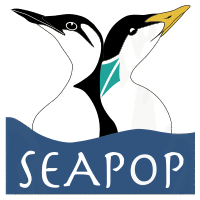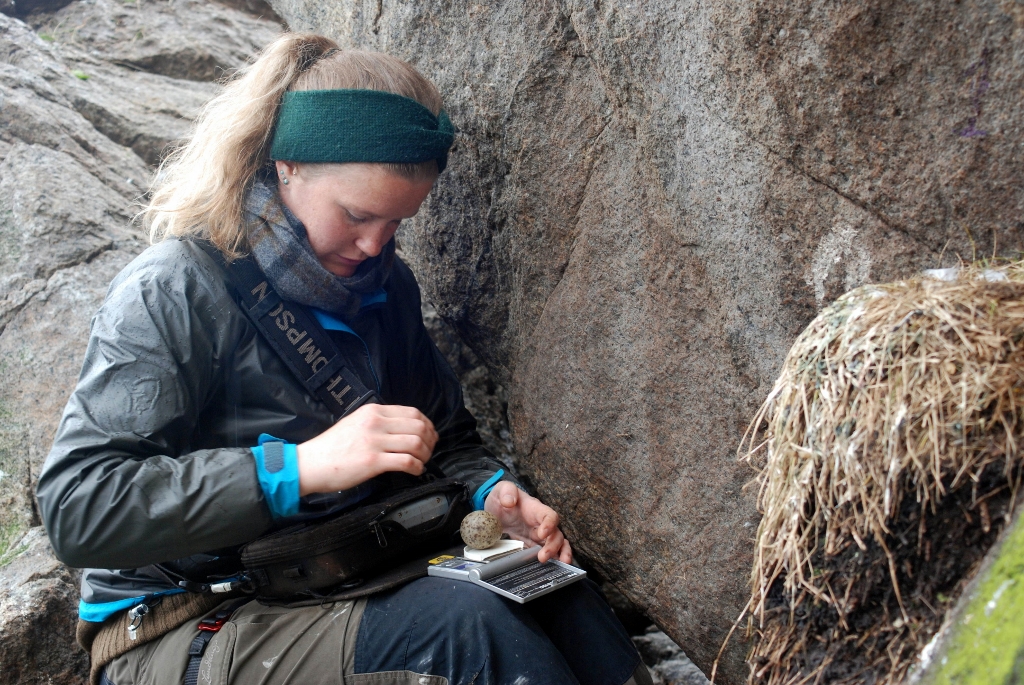Anda
Anda Nature Reserve and Ramsar site is located in Øksnes municipality in Nordland, at the north end of Langøya. Anda has one of the largest Atlantic puffin colonies in Nordland. Kittiwakes, razorbills, common guillemots, black guillemots, European shags, herring gulls and great black-backed gulls also breed on the island, which has been a SEAPOP key site since 2005. Contact person: Signe Christensen-Dalsgaard, NINA

Photo: Magdalene Langset
Location and description
Anda (69°04’ N, 15°10’ E) is a small island located approximately 6 km off Stø. There is a lighthouse on the island, and its square building is a landmark that can be seen from afar. Low cliffs rise steeply from the sea and mark the lower parts of the island, while the upper parts are covered by a thick layer of peat, riddled by puffin burrows. The vegetation at Anda is green and lush due to heavy fertilization by bird guano.
Anda and the surrounding area have been protected as a Nature Reserve since 2002. The reserve was established to protect a valuable coastal area and the natural flora and fauna on the island. The area is important as a breeding area for many auk species and other seabirds. The Nature Reserve covers 525 da, but only 166 da is land. From 15 April to 31 July, landing is forbidden to protect the breeding seabirds during their most vulnerable period.
This type of bird cliff with its proximity to food is a unique habitat that needs to be protected against human activity, and Anda became a Ramsar site in 2013. Although this does not result in a higher level of protection, Norway has, by this, taken on an international commitment to preserve this unique area.
Access
Anda is exposed to rough weather and sea, and landing conditions can be difficult even in the middle of summer. There is no natural harbour there, and the cliffs are steep all around the island. The boathouse is built high above the sea, out of reach of winter storms. If need be, it is possible to land a helicopter on the middle of the island.
Wildlife
Anda has one of the largest puffin colonies in Nordland, and the Atlantic puffin Fratercula arctica is the most abundant species on the island. Many black-legged kittiwakes Rissa tridactyla also breed on the steep cliffs. In addition, Anda is an important breeding site for European shag Phalacrocorax aristoteles, common guillemot Uria aalge, black guillemot Cepphus grylle, razorbill Alca torda, herring gull Larus argentatus and great black-backed gull L. marinus, plus a few pairs of common eiders Somateria mollissima.
The common guillemots on Anda do not breed on open ledges, but tightly packed in cracks and crevices. The razorbill also breeds well hidden, making these species hard to monitor on Anda. White-tailed eagles Haliaeetus albicilla, ravens Corvus corax and crows C. cornix are regular guests on Anda. They do not breed on the island, but hunt for eggs, chicks and adult birds. The peregrine falcon Falco peregrinus has also been seen harassing the kittiwake colony. Later in the season, when the puffins start to bring food back to their chicks, the Arctic skua Stercorarius parasiticus is a common visitor, stealing food from the puffins.
The Eurasian oystercatcher Haematopus ostralegus breeds on the island, while other species appear more occasionally. Red-breasted merganser Mergus serrator, common redshank Tringa totanus, great skua Stercorarius skua, common gull Larus canus, black-headed gull Chroicocephalus ridibundus, merlin Falco columbarius, Canada goose Branta canadensis, barnacle goose B. leucopsis and many other species visit the island, while northern fulmar Fulmarus glacialis, northern gannet Morus bassanus and terns fly by.
There are many passerines including rock pipit Anthus petrosus, white wagtail Motacilla alba, common redpoll Carduelis flammea and northern wheatear Oenanthe oenanthe. The snow bunting Plectrophenax nivalis can be seen on the island during the spring migration.
There are few mammals on the island, and no mice, rats or mink. Otters Lutra lutra may come ashore and there is a lot of harbour seals Phoca vitulina. Orcas Orcinus orca are commonly seen in the area, and sometimes the harbour porpoise Phocoena phocoena and larger whales. A moose Alces alces was once seen on the island!
Human activity
Anda lighthouse was the last manned lighthouse to be built in Norway, and was the last one to become automated. The lighthouse is own by the Norwegian Coastal Administration, and is visited only by their workers for maintenance and repairs. The living quarters is a two story wooden house, whereas the lighthouse itself is a 16 m high concrete tower. The light was first lit in 1932 and vacated and automated in 1987. The lighthouse became protected in 1999, has been refurbished and is now used as a field station for seabird monitoring on Anda. The protection of Anda does not prohibit traditional egg and down harvesting.
Fieldwork
Anda became a SEAPOP key site in 2005, with a primary focus on kittiwakes and puffins. The perfect location of this island between rich fjords in the east and the Vesterålen banks and the continental slope in the west provides several different feeding grounds for the seabirds. This makes Anda the perfect place to monitor in order to get a good total overview of the population trends of seabird colonies on the Norwegian coast.
The field season begins each year in May with counts of kittiwake nests, puffin burrows and black guillemots on the sea. Around mid-June, the fieldworkers start the monitoring of adult survival and breeding success of kittiwakes and puffins. In selected nests, chick growth is measured for both species throughout the entire breeding season. Food samples are also collected to see what kind of food the adults bring back to the chicks and what they eat themselves. At the end of the field season, the number of kittiwake chicks on the entire island is counted to assess the breeding success.





